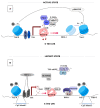Block-And-Lock: New Horizons for a Cure for HIV-1
- PMID: 33334019
- PMCID: PMC7765451
- DOI: 10.3390/v12121443
Block-And-Lock: New Horizons for a Cure for HIV-1
Abstract
HIV-1/AIDS remains a global public health problem. The world health organization (WHO) reported at the end of 2019 that 38 million people were living with HIV-1 worldwide, of which only 67% were accessing antiretroviral therapy (ART). Despite great success in the clinical management of HIV-1 infection, ART does not eliminate the virus from the host genome. Instead, HIV-1 remains latent as a viral reservoir in any tissue containing resting memory CD4+ T cells. The elimination of these residual proviruses that can reseed full-blown infection upon treatment interruption remains the major barrier towards curing HIV-1. Novel approaches have recently been developed to excise or disrupt the virus from the host cells (e.g., gene editing with the CRISPR-Cas system) to permanently shut off transcription of the virus (block-and-lock and RNA interference strategies), or to reactivate the virus from cell reservoirs so that it can be eliminated by the immune system or cytopathic effects (shock-and-kill strategy). Here, we will review each of these approaches, with the major focus placed on the block-and-lock strategy.
Keywords: HIV-1 latency; HIV-1 reservoir; antiretroviral therapy; block-and-lock; functional cure.
Conflict of interest statement
The authors declare no conflict of interest.
Figures





Similar articles
-
HIV "shock and kill" therapy: In need of revision.Antiviral Res. 2019 Jun;166:19-34. doi: 10.1016/j.antiviral.2019.03.008. Epub 2019 Mar 23. Antiviral Res. 2019. PMID: 30914265 Review.
-
Maraviroc Is Associated with Latent HIV-1 Reactivation through NF-κB Activation in Resting CD4+ T Cells from HIV-Infected Individuals on Suppressive Antiretroviral Therapy.J Virol. 2018 Apr 13;92(9):e01931-17. doi: 10.1128/JVI.01931-17. Print 2018 May 1. J Virol. 2018. PMID: 29444937 Free PMC article.
-
Low Inducibility of Latent Human Immunodeficiency Virus Type 1 Proviruses as a Major Barrier to Cure.J Infect Dis. 2021 Feb 15;223(12 Suppl 2):13-21. doi: 10.1093/infdis/jiaa649. J Infect Dis. 2021. PMID: 33586775 Free PMC article. Review.
-
The development of immune-modulating compounds to disrupt HIV latency.Cytokine Growth Factor Rev. 2012 Aug-Oct;23(4-5):159-72. doi: 10.1016/j.cytogfr.2012.05.003. Epub 2012 Jul 4. Cytokine Growth Factor Rev. 2012. PMID: 22766356 Review.
-
Screening of an FDA-approved compound library identifies levosimendan as a novel anti-HIV-1 agent that inhibits viral transcription.Antiviral Res. 2017 Oct;146:76-85. doi: 10.1016/j.antiviral.2017.08.013. Epub 2017 Aug 24. Antiviral Res. 2017. PMID: 28842263 Free PMC article.
Cited by
-
The integrated stress response signaling during the persistent HIV infection.iScience. 2023 Nov 8;26(12):108418. doi: 10.1016/j.isci.2023.108418. eCollection 2023 Dec 15. iScience. 2023. PMID: 38058309 Free PMC article. Review.
-
Integrated Analysis of the miRNA-mRNA Regulatory Network Involved in HIV-Associated Neurocognitive Disorder.Pathogens. 2022 Mar 27;11(4):407. doi: 10.3390/pathogens11040407. Pathogens. 2022. PMID: 35456082 Free PMC article.
-
A Review of the Development of Multitarget Molecules against HIV-TB Coinfection Pathogens.Molecules. 2023 Apr 10;28(8):3342. doi: 10.3390/molecules28083342. Molecules. 2023. PMID: 37110574 Free PMC article. Review.
-
Targeting Viral Transcription for HIV Cure Strategies.Microorganisms. 2024 Apr 8;12(4):752. doi: 10.3390/microorganisms12040752. Microorganisms. 2024. PMID: 38674696 Free PMC article. Review.
-
Defective HIV-1 genomes and their potential impact on HIV pathogenesis.Retrovirology. 2022 Jun 28;19(1):13. doi: 10.1186/s12977-022-00601-8. Retrovirology. 2022. PMID: 35764966 Free PMC article. Review.
References
-
- World Health Organization (WHO) HIV-AIDS. WHO; Geneva, Switzerland: 2020. Fact sheets.
-
- Hamlyn E., Ewings F.M., Porter K., Cooper D.A., Tambussi G., Schechter M., Pedersen C., Okulicz J.F., McClure M., Babiker A., et al. Plasma HIV Viral Rebound following Protocol-Indicated Cessation of ART Commenced in Primary and Chronic HIV Infection. PLoS ONE. 2012;7:e43754. doi: 10.1371/journal.pone.0043754. - DOI - PMC - PubMed
-
- Bahrami H., Budoff M., Haberlen S.A., Rezaeian P., Ketlogetswe K., Tracy R., Palella F., Witt M.D., McConnell M.V., Kingsley L., et al. Inflammatory markers associated with subclinical coronary artery disease: The multicenter AIDS cohort study. J. Am. Heart Assoc. 2016;5:e003371. doi: 10.1161/JAHA.116.003371. - DOI - PMC - PubMed
Publication types
MeSH terms
Substances
Grants and funding
LinkOut - more resources
Full Text Sources
Medical
Research Materials

